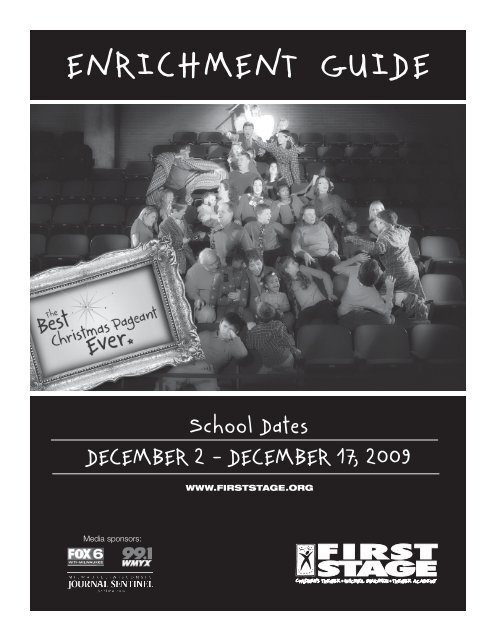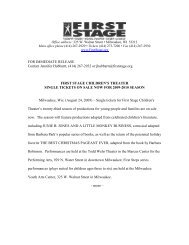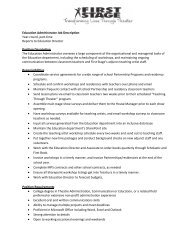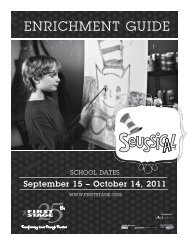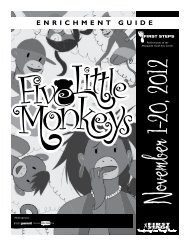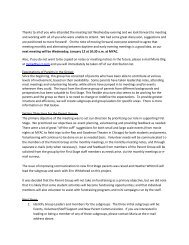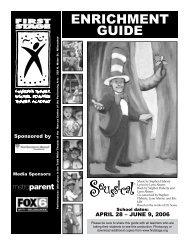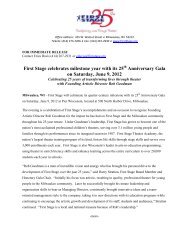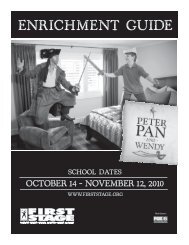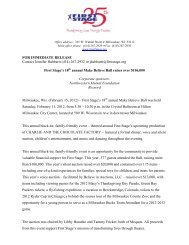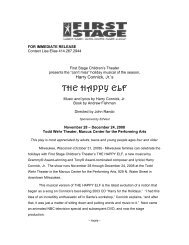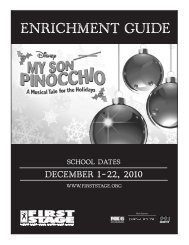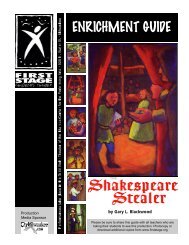The Best Christmas Pageant Ever Enrichment Guide - First Stage
The Best Christmas Pageant Ever Enrichment Guide - First Stage
The Best Christmas Pageant Ever Enrichment Guide - First Stage
- No tags were found...
Create successful ePaper yourself
Turn your PDF publications into a flip-book with our unique Google optimized e-Paper software.
ENRICHMENT GUIDESchool DatesDECEMBER 2 - December 17, 2009WWW.<strong>First</strong><strong>Stage</strong>.orgMedia sponsors:
Inside the <strong>Guide</strong>A Note to Teachers and ParentsSetting the <strong>Stage</strong>preparing for the playSynopsis ............. 2-4Pre-Show Questions ......5About the Author .........5Set in the 80’s ...........6Recommended Reading . . . 6For TeachersCurriculum connectionsbefore or after the playHISTORY<strong>Christmas</strong> Fast Facts ........ 7<strong>Christmas</strong> <strong>Pageant</strong>s . . . . . . . 14Exploring the <strong>Christmas</strong> Story . .. . . . . . . . . . . . . . . . . . . . . 15-17LANGUAGE ARTSFive <strong>Christmas</strong> Senses . . . . . . 8<strong>Christmas</strong> Carols .......... 10Picture That! . . . . . . . . . . . . . 11Dear Teachers and Parents,A time honored <strong>Christmas</strong> tradition will never be the same once the Herdmans—known as theworst kids in town—join the cast of the annual church <strong>Christmas</strong> pageant! <strong>First</strong> <strong>Stage</strong> is bringingback one of our most cherished holiday traditions, THE BEST CHRISTMAS PAGEANT EVER, andshaking things up even more by setting this production in the ‘80s. This treasured family tale willhave you laughing with delight and bouncing with joy…all while capturing the essence of the holidayseason and reminding us all of the true meaning of <strong>Christmas</strong>.Enclosed in this enrichment guide is a range of materials and activities intended to help youdiscover connections within the play through the curricula. It is our hope that you will use theexperience of attending the theater and seeing THE BEST CHRISTMAS PAGEANT EVER withyour students as a teaching tool. As educators and parents, you know best the needs and abilitiesof your students. Use this guide to best serve your children—pick and choose, or adapt, anyof these suggestions for discussions or activities. We encourage you to take advantage of theenclosed student worksheets— please feel free to photocopy the sheets for your students, or theentire guide for the benefit of other teachers.<strong>Best</strong> regards,SCIENCEExtinguish a Fire . . . . . . . . . . 12HUMANITIES<strong>Best</strong> Practices in Bully-Prevention. . . . . . . . . . . . . . . . . . . . . 22-24Social Studies<strong>Christmas</strong> Traditions . . . . . . . . 9Charity Fair . . . . . . . . . . . . 18-19Charity Planning <strong>Guide</strong> . . . 20-21ARTLittle Angel Ornaments ...... 13Curtain CallPost-ShowDiscussion Questions . ..... 24Who Said It? ............. 25AnswersPicture That! . . . . . . . . . . . . . 26Who Said It? ............. 27Julia MagnascoEducation Director(414) 267-2971<strong>First</strong> <strong>Stage</strong> Policies• <strong>The</strong> use of recording equipment and cameras are not permitted during the performance.• Food, drink, candy and gum are not permitted during the performance.• Electronic devices are not permitted in the theater space.• Should a student become ill, suffer an injury or have another problem, please escort himor her out of the theater space.• In the unlikely event of a general emergency, the theater lights will go on and the stagemanager will come on stage to inform the audience of the problem. Remain in your seats,visually locate the nearest exit and wait for the stage manager to guide your group fromthe theater.Seating for people with disabilities: If you have special seating needs for any student(s) anddid not indicate your need when you ordered your tickets, please call our School SalesSpecialist at (414) 267-2962. Our knowledge of your needs will enable us to serve youbetter upon your arrival to the theater.
Setting the <strong>Stage</strong> : SynopsisBeth Bradley opens our play bytelling the audience all about the awfulHerdman kids. <strong>The</strong> Herdman kids lie,smoke, steal and cuss, and all thekids in the neighorhood agree thatthe Herdmans are horrible! <strong>The</strong>y atedoughnuts that were bought for thefiremen, wrote a dirty word on theshell of a girl’s turtle and put tadpolesin the drinking fountain. But the mostimportant Herdman story is the timethey took part in the annual church<strong>Christmas</strong> pageant.<strong>The</strong>re are six Herdman children –Ralph, Imogene, Leroy, Claude, Ollieand Gladys – and they go around town stealing and beatingpeople up. It is hard to get away from them, but theone place they never go is church. Beth’s brother, Charlie,told his Sunday school teacher that the best thing aboutchurch was that there were no Herdmans. This made theteacher mad because all of the other children said nicethings about God, but Charlie simply said what everyone elsewas thinking.As the Bradleys return home from church one Sunday afternoon,Mr. Bradley tells Charlie that what he said wasn’t veryChristian of him. Mrs. Bradley doesn’t mind Charlie’s statementbecause it was very practical, considering Charlie was “blackand blue” from sitting next to Leroy Herdman in school last year.Mr. Bradley asks the children which Herdman is the worst andCharlie tells him that they’re all the worst. <strong>The</strong>n he says that he’llkeep going to church to stay away from the Herdmans. Mrs.Bradley likes this announcement because then Charlie can’targue about participating in the annual <strong>Christmas</strong> pageant.Nonetheless, the mention of the <strong>Christmas</strong> pageant causesCharlie to complain about being a shepherd in the play againthis year and how he rather not be in it at all. Mrs. Bradley saysshe would be very sad if Charlie wasn’t in the pageant, andwhen she looks at Mr. Bradley to back her up he explains thathe didn’t plan on attending the pageant this year.<strong>The</strong> family continues to discuss the<strong>Christmas</strong> pageant and how it neverchanges. <strong>Ever</strong>yone always has thesame parts and Charlie can’t stand itanymore. <strong>The</strong> children exit and Mrs.Bradley explains to Mr. Bradley howhard parish member Helen Armstrongworks on the <strong>Christmas</strong> pageant eachyear. In addition to the pageant, Mrs.Armstrong runs the potluck supperand is chairman of the Bazaar, and shewould also probably preach the sermonif she were allowed.Shortly after this discussion, Mr. Bradleyruns into Mr. Armstrong at the drugstore. Mr. Armstrong tells Mr. Bradley that his wife broke herleg and will be in traction until the first of the month, whichmeans she will not be able to run the pageant. Just as Mr.Bradley is telling his wife about this unfortunate event, Mrs.Armstrong’s assistant, Mrs. McCarthy, calls Mrs. Bradley toask if she will direct the pageant this year, and Mrs.Bradley accepts.Later that week, Mrs. Bradley is on the phone with Mrs.Armstrong while the family is setting up for dinner. Mrs.Armstrong drones on about the importance of the play whileMr. Bradley unhappily waits for his wife to get off of the phone.Charlie grabs five pieces of bread at dinner because LeroyHerdman stole his lunch again. Mr. Bradley finally leaves thetable. When the doorbell rings, Mrs. Bradley at last gets offthe phone with Mrs. Armstrong. She goes to answer the belland sees a fed-up Mr. Bradley in the doorway, begging forhis supper. <strong>The</strong> family finally sits down to eat dinner together,knowing there are sure to be many more interruptions from Mrs.Armstrong in the weeks to come.Mrs. Bradley wasn’t too concerned with Mrs. Armstrong’sdirections because she didn’t think she was going to encounterany problems while directing the same old boring <strong>Christmas</strong>pageant. However, Mrs. Bradley wasn’t counting on theHerdmans joining the play.2
Setting the <strong>Stage</strong>: Synopsis<strong>The</strong> following week at school, Leroy Herdman takes Charlie’slunch (like he always does) and gives it back without thedessert, a Reese’s Peanut Butter Cup. Charlie tells Leroy hedoesn’t care that he steals his dessert everyday becauseCharlie gets all of the dessert he wants at Sunday school.Charlie goes on and on about the different kinds of dessertsthey have at Sunday school and the Herdman boys getexcited. Sure enough, that Sunday the Herdmans show up tochurch… and just in time to hear about the <strong>Christmas</strong> pageant.At church, Imogene Herdman grabs Alice, a prim and properchoir member, and asks her about the pageant. Alice says thepageant is mostly about Mary and that she will probably playthe part of Mary because she knows it so well. This statementbrings a devilish look upon Imogene’s face.Mrs. Bradley herds the children along into the church andinforms them that today the main roles for the play will bechosen. <strong>The</strong> Herdmansenter the church andthe other children quicklymove away, causingthe Herdmans to end upsitting smack in the middleof the group. Mrs.Bradley welcomes themand starts explaining thepart of Mary. She asksfor volunteers to play therole, and Imogene raisesher hand high. Imogenealso says her brother,Ralph, would like to beJoseph. Mrs. Bradleydesperately tries to getthe other kids to volunteer.Elmer, the minister’sson, is excitedthat he finally doesn’thave to be Joseph,and Alice is too afraidto go against Imogene.Leroy Herdman shoutsout that he wants to bea wise man along withOllie and Claude. Andlastly, Gladys says she’ll take what’s left and ends up being theAngel of the Lord.<strong>The</strong> shepherds all make up excuses to get out of their roles butMrs. Bradley doesn’t give in to their demands. She says thatno shepherds may quit or get sick, and then she dismisses thechildren. Mrs. Bradley begins to ask Alice about why she didn’tvolunteer to be Mary, but gets distracted when Gladys starts tobeat up Elmer. Alice explains to Beth that Imogene told her shewas going to be Mary this year, and if Alice did anything to ruinit she’d shove a pussy-willow down her ear. That was enoughto scare Alice out of the role for good.News spreads throughout the congregation about theHerdmans being in the <strong>Christmas</strong> pageant this year. Mrs.Armstrong is convinced that had she been in charge, thisnever would have happened. Somehow Mrs. Bradley findsout what Mrs. Armstrong said and gets very upset. From thatpoint on, Mrs. Bradleydecides to dedicate herselfto directing the best<strong>Christmas</strong> pageant ever.While attempting to getthe first pageant rehearsalstarted, the Herdmankids continually interruptMrs. Bradley with questionsabout the <strong>Christmas</strong>story. She realizes thatthe Hedrmans havenever heard the Bible<strong>Christmas</strong> story, so shedecides to read it to thewhole group. <strong>The</strong> otherkids groan, as they haveheard it many timesbefore. While readingthe story, the Herdmansask questions that seemsilly to the other kids,and before long, theHerdmans get out of handand begin to act out theirown adaptation of thestory. Nothing seems tobe going as planned!3
Setting the <strong>Stage</strong>: SynopsisAs the pageant rehearsals continue, it is revealed that thenewborn baby cast to play Jesus quit the pageant becausehis mother didn’t want Imogene touching him. Not having ababy Jesus for the <strong>Christmas</strong> pageant is a major problem andit upsets Mrs. Bradley greatly, who tries to find one up until thelast rehearsal.During the last rehearsal Beth sees Alice writing in a little notebook.Alice says it’s a diary and Beth snatches it away fromher. It is actually a journal listing every account of what has beenhappening at the pageant rehearsals—the fights the Herdmansinitiate, the bad words they say in the church, and all the othergoings-on the Herdmans are responsible for, which Alice findsinexcusable. Alice tells Beth that she’s keeping it to show hermother and the Reverend when they want to know what happenedwhen the whole <strong>Christmas</strong> pageant turns out to be ahuge mess.As the pageant gets closer and closer, the issue with babyJesus arises again and Imogene says she can get a babyfrom a carriage outside of the supermarket. Mrs. Bradley tellsImogene that she cannot steal a baby, and finally decides thatthey will just use a doll for the role.A few days before <strong>Christmas</strong>, Mrs. Bradley leads the childrenthrough what is supposed to be a dress rehearsal; however,all of the kids have excuses as to why they are not in costume.<strong>The</strong> rehearsal begins late and the Herdman kids getout of control again. Gladys thinks she’s more of a superherothan an angel, and Imogene believes she can improvise herlines. Imogene and Ralph begin to fight and Mrs. Bradley getsdisgruntled. Mrs. Bradley tells the cast to take a five minutebreak, but in retrospect Beth shares with the audience thatthey never did go through the entire play. During their break,Mrs. McCarthy saw smoke coming from the ladies’ room fromImogene’s cigar. Mrs. McCarthy reacted by yelling “fire!” and firetrucks arrive at the church.let this happen and tells him that she is going to put on the best<strong>Christmas</strong> pageant the town has ever seen.<strong>The</strong> night of the <strong>Christmas</strong> pageant finally arrives, and the wholetown has decided to show up just to see what the Herdmanswill do this time. Mrs. McCarthy warms up the audience byleading them in singing a few <strong>Christmas</strong> carols. ReverendHopkins thanks the audience for coming and introduces Mrs.Bradley. <strong>The</strong> play begins and the kids wonder if Imogene andRalph will actually enter the stage. <strong>The</strong>y eventually enter, anddo surprisingly well. Next it’s Gladys’ turn to come on stage andwhile her part is a little flustered at first, in the end she does afine job. <strong>The</strong> three wise men- Claude, Ollie and Leroy- greetMary and Joseph and instead of handing over frankincenseand myrrh, they offer ham. <strong>The</strong>n, as the narrator announcesthat the wise men depart to their own country, the three boystake a seat next to Joseph as he hands out “it’s a boy” cigars.<strong>The</strong> play concludes with the shepherds and angels greetingJesus and singing Silent Night. <strong>The</strong> song ends and the play issupposed to be over, however, Imogene steps forward carryingthe baby Jesus doll and sings the next verse of the song all onher own. Reverend Hopkins concludes the play and tells everyoneto go to the basement for the after-party. All of the childrenleave except the Herdmans, Beth, Charlie and Alice.<strong>The</strong> Reverend, Mrs. McCarthy and Mrs. Armstrong let Mrs.Bradley know that this pageant was the best one yet. Beth tellsImogene that she did a great job as Mary; and Charlie goes togive Leroy back his ham but he won’t accept – it was a gift forbaby Jesus. <strong>The</strong> boys put their arms around each other andgo down to the party. Mr. Bradley praises his wife for a job welldone and the two of them go and find their children to celebrate<strong>Christmas</strong>. <strong>The</strong> performance ends and the entire Companyreturns to the stage singing Joy to the World.<strong>The</strong> only fire that the firemen found was in the kitchen becauseall of the applesauce cakes burned. Mrs. Bradley is irate withMrs. McCarthy for making such a huge scene when all shesaw was a little bit of smoke. Reverend Hopkins enters andasks the ladies what happened. <strong>The</strong>y explain the situation tohim and he suggests canceling the <strong>Christmas</strong> pageant sinceeveryone thinks it’s going to be a disaster. Mrs. Bradley won’t4
About the Author & PlaywrightTaken directly from: http://usawrites4kids.drury.edu/authors/robinson/Barbara RobinsonI grew up in a southern Ohio river town – Portsmouth – and that small townatmosphere has affected most of my writing. My mother, widowed when I wasthree years old, taught school for forty-nine years in that same small town, andher major (indeed, only) extravagance was books. I grew up with, and quicklyadopted, the notion that reading was the only way to fill up every scrap ofloose time you could snatch.I had the benefit, as well, of a wide variety of aunts and uncles and cousins,plus the extended family so common to small town life – the neighbors, friends,teachers, bus drivers, mailmen, local heroes, and even a local blacksmith...great stuff to feed the imagination.I began writing very early – poems, plays, stories – and just never quit. Iattended local schools and then, being both book-struck and stage-struck,found a college – Allegheny College – where I could satisfy both passions.I’ve been a short story writer, with some 40-50 stories in McCall’s, Ladies’ Home Journal, Redbook, etc.; a playwright;an occasional poet, and finally and most happily, an author of children’s books...happily, because there’s no greateraudience than boys and girls who read books and demand that those books be the most exciting, the most mysterious,the most touching, the funniest...the <strong>Best</strong>.I live and write in a suburb of Philadelphia, and I have two daughters – Carolyn, who is a nurse, and Marjorie, who is asixth grade teacher and at home now with my grandchildren Tomas and Marcos, and all these people read books like crazy!Pre-Show Questions1. <strong>The</strong> church <strong>Christmas</strong> pageant is a tradition for the Bradley family, and many other families in the church community.What are some holiday traditions your family, church, or school participate in every year? If you could create a newholiday tradition for your family, church, or school, what would it be, and why?2. .Being in a <strong>Christmas</strong> pageant is similar to being in a play. Have you ever been in a play or pageant before? If so,.what was the most exciting part about being in a play? If not, would you like to be in a play or pageant some day—why, or why not?3. <strong>The</strong> holiday season is a time for giving to others. Many times during the <strong>Christmas</strong> season we are encouraged togive of our time, talents, or treasures to those who are less fortunate than we are. This holiday season, what areways you can selflessly give of your time, talents, or treasures to others in need?4. <strong>The</strong>re are a number of different <strong>Christmas</strong> carols sung throughout the <strong>Christmas</strong> pageant. What are <strong>Christmas</strong>songs .that you know, and what are some of your favorites to hear and sing?5
<strong>The</strong> <strong>Best</strong> <strong>Christmas</strong> <strong>Pageant</strong> <strong>Ever</strong> – set in the 1980’sF irst <strong>Stage</strong>’s production of <strong>The</strong> <strong>Best</strong> <strong>Christmas</strong> <strong>Pageant</strong> <strong>Ever</strong> is set in the decade of the 1980s. <strong>The</strong> 80s was a timethat most of us adults remember fondly, and beyond the political developments that occurred throughout the world during the80s, what we seem to remember most about this period in time was the pop culture. New toys, new fashions, new televisionshows and channels became mainstream and created a style that was unique and distinctive to this generation. And althoughmany of these trends had only a brief existence in history, their legacy and memory will last much longer.Below are a number of links to help you reminisce on the styles, trends, and fads of the 80s, and to help introduce this culturaltime period to your students. While watching the production, see if you can pick up on the 80s references scattered throughoutthe show and apparent in the costumes and set. Like, totally have a primo rad time!• Cartoons from the 80s: http://www.fromthe80s.com/tv/cartoons.php• Commercial slogans from the 80s: http://www.fromthe80s.com/tv/commercials.php• Clothing fashions from the 80s: http://www.fromthe80s.com/fads/clothes.php, http://www.liketotally80s..com/80s-fashion.html• Popular movies from the 80s: http://www.fromthe80s.com/movies/, http://www.liketotally80s.com/80smovies-tv.html• Popular music from the 80s: http://www.fromthe80s.com/music/, http://www.liketotally80s.com/80s-music.html• Popular toys from the 80s: http://www.liketotally80s.com/80s-toys.html#mylittleponyRecommended reading<strong>The</strong> <strong>Best</strong> School Year <strong>Ever</strong> by Barbara Robinson<strong>The</strong> <strong>Best</strong> Halloween <strong>Ever</strong> by Barbara RobinsonMy Brother Louis Measures Worms: And Other LouisStories (Charlotte Zolotow Book) by Barbara RobinsonChicken Soup for the Soul <strong>Christmas</strong> Treasury for Kids:A Story a Day from December 1st through <strong>Christmas</strong> forKids and <strong>The</strong>ir Families by Jack Canfield, Irene Dunlap,Patty Hansen, and Mark Victor HanseHow To Have <strong>The</strong> <strong>Best</strong> <strong>Christmas</strong> <strong>Ever</strong> (<strong>The</strong> <strong>Christmas</strong>Book) by Juliana FosterA Midnight Clear: Family <strong>Christmas</strong> Storiesby Katherine Paterson6
<strong>Christmas</strong> Fast FactsHistory Classroom InformationTaken from: http://www.history.com/content/christmas/fast-factsEach year, 30-35 million real <strong>Christmas</strong> trees are sold in the United States alone.<strong>The</strong>re are 21,000 <strong>Christmas</strong> tree growers in the United States, and trees usuallygrow for about 15 years before they are sold.Today, in the Greek and Russian orthodox churches, <strong>Christmas</strong> is celebrated 13 days afterDecember 25th, which is also referred to as the Epiphany or Three Kings Day. This is the day itis believed that the three wise men finally found Jesus in the manger.In the Middle Ages, <strong>Christmas</strong> celebrations were rowdy and raucous—a lot like today’sMardi Gras parties.<strong>Christmas</strong> wasn’t a national holiday in early America—in fact Congress was in session onDecember 25, 1789, the country’s first <strong>Christmas</strong> under the new constitution.<strong>Christmas</strong> was declared a federal holiday in the United States on June 26, 1870.<strong>The</strong> first eggnog made in the United States was consumed in Captain John Smith’s1607 Jamestown settlement.Poinsettia plants are named after Joel R. Poinsett, an American minister to Mexico,who brought the red-and-green plant from Mexico to America in 1828.<strong>The</strong> Salvation Army has been sending Santa Claus-clad donation collectors into thestreets since the 1890s.Rudolph, “the most famous reindeer of all,” was the product of Robert L. May’simagination in 1939. <strong>The</strong> copywriter wrote a poem about the reindeer to help lure customersinto the Montgomery Ward department store.Construction workers started the Rockefeller Center <strong>Christmas</strong> tree tradition in 1931.7
Five <strong>Christmas</strong> SensesLanguage Arts/Art Student WorksheetAdapted from: http://www.lessonplanspage.com/LA5<strong>Christmas</strong>SensesPoemPK.htmActivity1. Begin by sharing the following poem with students. If possible, write this poem on the board or on chart paper, so studentscan follow along with your reading, and refer back to it later in the lesson.MY FIVE CHRISTMAS SENSES POEMI see the <strong>Christmas</strong> treeAnd children on Santa’s kneeI smell the cookies I makeAnd the <strong>Christmas</strong> cakeI hear bells ringingAnd children singingI taste the <strong>Christmas</strong> sweetsAnd all the other treatsI feel the <strong>Christmas</strong> toysMade for girls and boys2. After reading, ask students to recall the five senses mentioned in the poem. Highlight or underline these senses in the text.Next, ask them to identify the rhyming words in the poem. Circle these rhyming words.3. Create a table on the board with the following five headings: Smell, Taste, Hear, Feel, See. Have students identify other thingsthey smell, taste, hear, feel, and see during the holiday season. Write these ideas under the correct heading.4. Next, take a few of the ideas from each sense category and as a class brainstorm other words that rhyme with each of theseselected sensory words. Again, write the responses on the board.5. Once the class has thoroughly brainstormed holiday sensory images and rhyming words, together as a class write a new FIVECHRISTMAS SENSES POEM.a. Allow older students to individually write a new FIVE CHRISTMAS SENSES POEM.8
<strong>Christmas</strong> Traditions: Holiday CardsSocial Studies Classroom ActivityActivity1. Begin by creating a chart on the board with the following headings: family, school, community.2. Ask students to define the word “tradition”—where have they heard this word used, and what does it mean to them.a. Share a few dictionary definitions of tradition with students: the passing down of elements of a culture fromgeneration to generation; a time-honored practice or set of such practices;3. Next, as a class, come up with a group definition for the word “tradition.” Write this definition on the board.4. Have students begin thinking about their own holiday traditions. Prompt students with the questions listed below, and jotdown their responses on the board under the Family heading.a. Does your family decorate your house in any special ways during the holiday season? And if so, what are thesedecorations?b. Does your family make special meals or eat special foods during the holiday season? And if so, what are thesefoods or meals?c. Does your family visit any relatives or go any place special during the holidays? And if so, who do you visit or wheredo you go?d. Does your family follow any other special practices during the holiday season, such as sending out <strong>Christmas</strong> cards,<strong>Christmas</strong> caroling, visiting Santa Claus, celebrating St. Nick’s Day, wrapping presents, watching specific holidaymovies, going to <strong>Christmas</strong> church services, etc.5. Continue this same format to explore school holiday traditions and community holiday traditions.6. Once completed, ask students what traditions they like best, and why?Next, ask students why they think people follow traditions?7. Tell students that they are all going to be creating a new tradition this year bymaking holiday cards displaying some of our favorite holiday traditions that wecan send out to all the other teachers and classrooms in the school.8. Provide each student with one sheet of firm paper, and have them fold thepaper to form a card. On the outside of the card, students should draw apicture of their favorite holiday tradition. <strong>The</strong>n on the inside of the card, studentscan write a message wishing holiday cheer and good will.9. Once the cards are finished, have the students go around to the other classrooms at the school and pass out their cards to each teacher andadministrator.9
<strong>Christmas</strong> CarolsLanguage Arts/History Classroom ActivityHistory taken from: http://www.whychristmas.com/customs/carols_history.shtmlIn those days, a decree went out from Caesar Augustus that all the world should be enrolled.This was the first enrollment, and all went, each to his own city.Joseph went from the city of Nazareth to the city ofDavid which is called Bethlehem:“O LITTLE TOWN OF BETHLEHEMO little town of Bethlehem, how still we see thee lie!Above thy deep and dreamless sleep the silent stars go by:Yet in the dark streets shineth the everlasting Light:<strong>The</strong> hopes and fears of all the years are met in thee tonight.”–Maxine and Choir<strong>The</strong> History of <strong>Christmas</strong> CarolsCarols were first sung in Europe thousands of years ago, but these were not <strong>Christmas</strong> carols. <strong>The</strong>y were pagan songs, sungat the Winter Solstice celebrations as people danced around stone circles. <strong>The</strong> Winter Solstice is the shortest day of the year,usually taking place around the 22nd of December. <strong>The</strong> word carol actually means: a dance or song of praise and joy!Early Christians took over the pagan solstice celebrations with <strong>Christmas</strong> and gave people Christian songs to sing insteadof pagan ones. However, not many people liked them as they were all written and sung in Latin, a language that commonpeople couldn’t understand. By the time of the Middles Ages (the 1200s), most people had lost interest in celebrating<strong>Christmas</strong> altogether.This was changed by St. Francis of Assisi when, in 1223, he started his Nativity Plays in Italy. <strong>The</strong> people in the plays sangsongs or “canticles” that told the <strong>Christmas</strong> story. Sometimes, the choruses of these new carols were in Latin, but normally theywere in a language that the people watching the play could understand and join in! <strong>The</strong> new carols spread to France, Spain,Germany and other European countries.Before carol singing in public became popular, there were sometimes official carol singers called “Waits”. <strong>The</strong>y were called“Waits” because they only sang on <strong>Christmas</strong> Eve (this was sometimes known as “watchnight” or “waitnight” because theshepherds were watching their sheep when the angels appeared to them), when the <strong>Christmas</strong> celebrations began.New carol services were created and became popular, as did the custom of singing carols in the streets. Both of these customsare still popular today! One of the most popular types of carol services are Carols by Candlelight services. At this service,the church is only lit by candlelight and it feels very <strong>Christmas</strong>sy! Carols by Candlelight services are held in countries all overthe world.Activity1. As a class, have students brainstorm a list of <strong>Christmas</strong> carols. Write the titles on the board.a. Ask students to summarize the story behind all or some of these carols.b. Ask students: what are other themes or story ideas a new <strong>Christmas</strong> carol could be written about? Again, write theseideas on the board.2. Inform the class that they are going to write new carols. Place students into pairs or small groups.3. Once in their groups, they must first choose a theme or story idea to write their song about. Students may use thebrainstormed list on the board, or come up with a new song idea.4. Next, using the tune of “Mary Had A Little Lamb,” students must create their new <strong>Christmas</strong> carol.5. Allow groups ample time to come up with their song ideas, and assist groups as needed.6. Once the songs are finished, have the groups share their new <strong>Christmas</strong> songs by hosting a caroling session during theschool day. If possible, provide <strong>Christmas</strong> cookies and hot chocolate for students after their caroling!10
Picture That! Looking at <strong>Christmas</strong> Songs through PicturesLanguage Arts/Art Student WorksheetAdapted from: http://www.santalady.com/xmasgame/xmassong.htmlGood evening everyone and welcome to our annual <strong>Christmas</strong> pageant. It’s nice to see so very, very many people heretonight. I know you are all eager for the pageant to begin, but we like to get everyone involved, so if you all take out thissheet of paper, we’re going to have ourselves a little carol sing and provide our own pre-show entertainment. –Mrs. McCarthyOn each space in the calendar below is a picture representing the title of a popular <strong>Christmas</strong> song.See how many <strong>Christmas</strong> songs you can decode—remember to look carefully at the picture for all thehidden meanings! Good luck!1.2.3.4.5.6.7.8.9.10.11.12.13.14.15.16.17.18.19.20.21.22.23.24.Now, on the back of this worksheet, choose your favorite <strong>Christmas</strong> song tocreate your own drawing of. Be creative!11
Extinguish a FireScience Classroom ActivityAdapted from: http://www.scholastic.com/magicschoolbus/simplescience/archive/labs/pop.htmGrace! Grace! What is going on? I was just attacked out there by every woman from this church.Erma said they set fire to the kitchen. Someone else said they set fire to the ladies’ room!-Reverend HopkinsWhen baking soda and vinegar mix they create a gas known as carbon dioxide. It is carbon dioxide gas thatgives soda its pop. Carbon dioxide gas is also what creates the fire-damping foam in some fire extinguishers.Materials:Baking sodaVinegarZiplock bagActivity:1. Place students with a partner, and give each pair one Ziplock bag.2. <strong>First</strong>, have students put two big spoonfuls of baking soda in a plastic Ziplock bag.3. <strong>The</strong>n, students should seal their bag nearly closed, leaving only a small opening.4. Next, have students pour about half a cup of vinegar into the bag. Right aftewards,they should quickly seal the bag closed and gently shake the mixture.5. Have students observe what happens to the mixture in their bag. Explain to themthat they have just made a gas known as carbon dioxide.6. While observing the newly created gas in their Ziplock bags, ask students if they canexplain why carbon dioxide foam would make a good fire extinguisher?a. Carbon dioxide is good for putting out fires because it displaces air(oxygen) and, therefore, the fire then cannot breathe. With the “woosh”of a CO2 extinguisher comes a cold white cloud of carbon dioxide thatrushes out of the nozzle and covers the target area like a fog. It pushes air(and the oxygen the fire needs to continue to burn) out of the way.Presto! No more fire!7. Test these mini-fire extinguishers by lighting a small candle, shaking the vinegarand baking soda mixture again vigorously, and then pouring the mixture ontothe flame. Have students watch carefully and note what happens to theflame when it comes into contact with the carbon dioxide gas.12
Little Angel OrnamentsArt Classroom ActivityAdapted from: http://www.lessonplanspage.com/ArtLittleAngelsCraftIdea-HolidayPK.htmNow you little children will be our angels, so please remind your mothersthat you’ll need bedsheets . . .–Mrs. BradleyMaterialsWhite construction paper (nice and sturdy), one sheet per studentSkin-toned construction paper (nice and sturdy), one sheet per studentVarious colors of construction paper (nice and sturdy), one sheet per studentScissorsGlueTapeMarkers or crayonsYarn in various hair colorsChenille strips in gold and silver colors (for the halo)ThreadGlitter (optional)Activity1. Give each student a piece of white paper and a piece of skin-toned paper. On the white paper, have students trace boththeir hands. On a sheet of paper of the students’ choice, have students trace their footprint (keeping their shoe on).2. Next, have students cut out their traced hands and foot. Assist students with this task as needed.3. On the skin-toned paper, have students draw and cut out a circle, which will serve as the angel’s head. If you prefer, thecircles can be pre-cut and simply handed out to students.4. Once everything is cut out, the shoed foot acts as the body of the “little angel.” <strong>The</strong> hands are the wings. <strong>The</strong> heel of the footis where the head should be placed.5. Glue the head to the angel body (if using glitter, wait to glue on the wings; if not, go ahead and assemble the entire angel).Allow students to draw a face, and to decorate the angel with their crayons and markers. Once they have completed that,allow them to cut bits of yarn in their own hair color to be glued onto the angel’s head.a. If using glitter, add glitter to the angel wings, and then glue them onto the angel.6. Finish the angels by cutting a short piece of a chenille strip and forming it into the shape of a halo. Secure the halo onto theangel by taping it onto the backside of the angel.7. Tie a loop of thread onto the halo, so these angels can hang from the <strong>Christmas</strong> tree!13
<strong>Christmas</strong> <strong>Pageant</strong>sHistory Classroom InformationTaken from: http://www.whychristmas.com/customs/nativity.shtml<strong>Christmas</strong> is the celebration of the birth of Jesus. It is traditional for many primary schools, Sundayschools, and churches to put on a <strong>Christmas</strong> <strong>Pageant</strong>, or Nativity Play, for parents and the communityduring the holiday season. <strong>The</strong> Nativity Play recreates the scene of Jesus’ birth in the stable, and tellsof how Mary and Joseph were visited by the Shepherds and Wise Men. <strong>The</strong> parts of Mary, Joseph, theShepherds and the Wise Men are often played by children.In the past live animals including an ox and donkey and other farm animals were used in the plays.Sometimes they still are, but it is now more common for children to dress up as the animals in costumesor to have animal props.<strong>The</strong> first Nativity Play was not performed by children, but in a cave by Monks in Italy. St. Francis of Assisiand his followers acted in the first play in 1223 to remind the local population that Jesus was born forthem, as he was born into a poor family like theirs and not to a rich family. St. Francis told the part ofeach character in the story himself, using wooden figures in the play. After a couple of years, the play hadbecome so popular that real people played the parts of the characters in the story. Songs were sung bythe people taking part and they became what we call carols today!14
Exploring the <strong>Christmas</strong> Story<strong>The</strong>ology/History Classroom ActivityTaken from: http://www.daniellesplace.com/HTML/<strong>Christmas</strong>PartyIdea.htmlImogene, this is the <strong>Christmas</strong> story from the Bible … Haven’t you ever heard the <strong>Christmas</strong> storyfrom the Bible? Well, that’s what this <strong>Christmas</strong> pageant is, so I’d better read it to you.–Mrs. BradleyBefore beginning this fun and active telling of the <strong>Christmas</strong> story, place students into smallgroups of four or five.<strong>The</strong> teacher or facilitator will be reading small segments of the <strong>Christmas</strong> story from the booksof Luke and Matthew. Students are to listen carefully because there will be discussion questionsafter each reading, followed by fun games related to the readings.Traveling to BethlehemN Reading: Luke 2:1-7In those days Caesar Augustus issued a decree that a census should be taken ofthe entire Roman world. (This was the first census that took place while Quiriniuswas governor of Syria.) And everyone went to his own town to register. SoJoseph also went up from the town of Nazareth in Galilee to Judea, to Bethlehemthe town of David, because he belonged to the house and line of David. Hewent there to register with Mary, who was pledged to be married to him andwas expecting a child. While they were there, the time came for the baby to beborn, and she gave birth to her firstborn, a son. She wrapped him in cloths andplaced him in a manger, because there was no room for them in the inn.Discussion QuestionsWho went traveling in this story?Why did they have to travel?Where did they travel to?What happened to Mary when they were in Bethlehem?What happened when they tried to get a place to rest in the inn?Activity: Musical ChairsThroughout the classroom, place colored papers (or anything else to identify a spot as a “resting place”) on chairs. Makesure you have “resting places” identified for the number of students minus one. Have students walk around the parameterof the classroom and when the music stops, they must find a “resting place” to sit down. Whoever did not find a restingplace is out. Take away a “resting place” after each time, until just one child remains.15
Exploring the <strong>Christmas</strong> Story (continued)Language Arts/Math Classroom Activity<strong>The</strong> Angel of the Lord Appearing to Shepherds in their FieldsN Reading: Luke 2: 8-14And there were shepherds living out in the fields nearby, keeping watch over their flocks at night. An angel of the Lord appearedto them, and the glory of the Lord shone around them, and they were terrified. But the angel said to them, “Do not be afraid. Ibring you good news of great joy that will be for all the people. Today in the town of David a Savior has been born to you; he isChrist the Lord. This will be a sign to you: You will find a baby wrapped in cloths and lying in a manger.” Suddenly a great companyof the heavenly host appeared with the angel, praising God and saying, “Glory to God in the highest, and on earth peaceto men on whom his favor rests.”Discussion QuestionsWho were living out in the fields nearby and what were they doing?Who appeared to them?How did that make them feel?What’s the first thing the angel said to them?A great company of angels then filled the sky. What did they say or sing?N Reading: Luke 2: 8-14When the angels had left them and gone into heaven, the shepherds said to one another, “Let’s go to Bethlehem and see thisthing that has happened, which the Lord has told us about.” So they hurried off and found Mary and Joseph, and the baby,who was lying in the manger. When they had seen him, they spread the word concerning what they had been told aboutthis child, and all who heard it were amazed at what the shepherds said to them. But Mary treasured up all these things andpondered them in her heart. <strong>The</strong> shepherds returned, glorifying and praising God for all the things they had heard and seen,which were just as they had been told.Discussion QuestionsWhat did the shepherds say when the angels left?<strong>The</strong> shepherds started telling others what they had seen. What was people’s reaction?What did the shepherds do as they returned?Activity: Shepherds’ RaceProvide each student with one large marshmallowand ask them to decorate the marshmallow withmarkers or pens to make it look like a little sheep.Have students sit with their team and provide eachteam with a staff (candy cane). <strong>The</strong> floor of the classroomshould be cleared and the teams should belined up on one side of the classroom. Explain to theteams that each “shepherd” will individually have toguide their sheep into the sheepfold, which shouldbe located on the other side of the classroom, beforethey can leave for Bethlehem. <strong>The</strong> students shouldplace their sheep on the floor, moving the sheep forwardwith the candy cane staff and into the sheepfoldplaced at the end of the room. As soon as the first“shepherd” is back, they must pass the staff to thenext “shepherd,” etc. <strong>The</strong> first team who has all theirsheep safely in the fold wins!<strong>The</strong>ology/History Classroom Activity16
Exploring the <strong>Christmas</strong> Story (continued)<strong>The</strong> Visit of the MagiLanguage Arts/Math Student Worksheet<strong>The</strong>ology/History Classroom ActivityN Reading: Matthew 2:1-6After Jesus was born in Bethlehem in Judea, during the time of King Herod, Magi from the east came to Jerusalem and asked,“Where is the one who has been born king of the Jews? We saw his star in the east and have come to worship him.” WhenKing Herod heard this he was disturbed, and all Jerusalem with him. When he had called together all the people’s chief priestsand teachers of the law, he asked them where the Christ was to be born. “In Bethlehem in Judea,” they replied, “for this is whatthe prophet has written: “’But you, Bethlehem, in the land of Judah, are by no means least among the rulers of Judah; for out ofyou will come a ruler who will be the shepherd of my people Israel.’”Discussion QuestionsAfter Jesus was born some important visitors traveled to Jerusalem to visit him. Who were they?How did the Wise Men know that Jesus was born?When the Wise Men asked around where they could find the new king, what was the answer?How did King Herod’s advisors know that Jesus would be born in Bethlehem?How did the prophet describe the ruler who would be born in Bethlehem?Activity: Star Gazing PuzzleAgain, have students sit with their team members. Each team will get an envelope with a number of stars in it, a glue stick, anda strip of construction paper or butcher paper to make a banner with. Each star has a word on it, and when put in the rightorder it will show a sentence. Teams must unscramble their words to decode the correct phrase and then glue the stars on thebanner in the right order. Once finished, the teams must run to the front of the classroom, hold up the banner, and call out theirphrase. Phrases can be taken from the <strong>Christmas</strong> story scripture readings:• Where is the one who has been born king of the Jews?• We saw his star in the east and have come to worship him.• Glory to God in the highest, and on earth peace to men.• Do not be afraid. I bring you good news of great joy that will be for all the people.• For out of you will come a ruler who will be the shepherd of my people Israel.N Reading: Matthew 2: 9-11After they had heard the king, they went on their way, and the star they had seen in the east went ahead of them until it stoppedover the place where the child was. When they saw the star, they were overjoyed. On coming to the house, they saw the childwith his mother Mary, and they bowed down and worshiped him. <strong>The</strong>n they opened their treasures and presented him with giftsof gold, and of incense, and of myrrh.Discussion QuestionsAfter the Magi got the answer from King Herod, what did they do?How did the Wise Men find their way?How did they feel when they saw the child?What did the Magi do as they came close to the child?What presents did the Magi bring?17
A Community of Givers – Charity FairSocial Studies/Philanthropy Classroom ActivityTaken from: http://learningtogive.org/lessons/unit413/lesson3.htmlBETH: It’s a HAM!ALICE: Bet they stole it.BETH: <strong>The</strong>y did not. It came from their welfare food basket.And if they want to give away their own ham, I guess they can do it.Activity1. Ask students to name some activities which they have been told that they are too young to do. Write their list on the board.Ask students if there are any activities on the list that they feel they CAN do. Tell them you don’t think they are too young tocreate a community-wide service project.2. Read aloud about successful service projects designed by children (listed below). Also let the students explore websitesand books for more inspiring projects by children who are making a difference.a. Alex’s Lemonade Stand http://www.alexslemonade.org/ (one child’s story of raising over a million dollars for cancerresearch) September 1, 2007b. Just Give—Kids Corner: Inspiring Kids Making a Difference http://www.justgive.org/html/kidscorner/inspiringkids.html(examples of kids helping animals, children, and the earth)c. Lewis, Barbara A. <strong>The</strong> Kid’s <strong>Guide</strong> to Social Action. Free Spirit Publishing, 1998. ISBN: 1575420384d. Peace Corps Kids World: Make a Difference http://www.peacecorps.gov/kids/difference/ (stories about kids solvingsome local problems creatively) September 1, 2007e. Siegal, Danny and Naomi Eisenberger. Mitzvah MAGIC: What kids can do to change the world. Kar-BenPublishing, 2002. ISBN: 1580130348f. Trevor’s Campaign for the Homeless. http://www.volunteersolutions.org/volunteerway/org/217084.html (tells story ofone boy’s efforts that evolve into something big) August 31, 20073. After sharing these stories, ask students if they feel any of these young people are heroes, and if so, what makes themheroes? Continue by asking: how do you think these young people succeeded in making the project work? Follow up byasking: If you could make any service project you could dream of into a success, what would it be and why?4. Tell students that some needs are met by nonprofit organizations and supporting these organizations is good for thecommunity. Share with students the definition of nonprofit organizations:a. Nonprofit corporations exist solely to provide programs and services that are of public benefit. Often theseprograms and services are not otherwise provided by local, state, or federal entities. While they are able to earn aprofit, more accurately called a surplus, such earnings must be retained by the organization for its future provisionof programs and services. Earnings may not benefit individuals or stake-holders.5. Have students research and brainstorm a list of nonprofit organizations in their community. Write this list of nonprofits onthe board, and briefly describe how they serve the community (ie: education, medical aid, food, shelter, clothing, culture,other community needs, etc.).18
A Community of Givers – Charity Fair (continued)6. Inform students that the class is going to create and participate in a charity fair for the school community, in which manydifferent nonprofit organizations are represented and explained. Those who visit the fair have a chance to contribute to theissues of their choice.a. <strong>The</strong> fair can take place right in the classroom during the school day, if you choose, or another location or time. Setthe date and time for the fair well in advance and assign students to design a flier to send home, place around theschool, and display in the community inviting people to the fair. Be sure to invite families, school personnel, andcommunity members.7. Place students into pairs or small groups. Each group will pick a charity/issue and find a way to support it and represent itcreatively and factually at the charity fair.a. Pass out the included worksheet Charity Fair Planning <strong>Guide</strong> to help guide the students through the planning process.<strong>The</strong>y will choose their issue, conduct research, create a display, and practice and present the information at the fair.b. Research may include finding the website of a charity, studying an issue, and visiting local nonprofit organizations.Students may contact agencies to obtain information, phone numbers, and literature to display at the charity fair.c. <strong>The</strong> students should display success stories, and/or examples of ways to help the nonprofit organization they aresupporting. Alternatively, the students may design a project such as raising money for an issue/charity by creating aservice or good to sell or collecting blankets, food, books, or toys for people who need those supplies. Allowthe students to be creative so that people who come to the fair may give money, donate supplies, or learn aprocedure (such as recycling).8. After the fair, have the students write letters to their charities that explain where the money or gifts are coming from.Deliver the donations as soon as possible.19
A Community of Givers – Charity Planning <strong>Guide</strong>Social Studies/Philanthropy Student WorksheetTaken from: http://learningtogive.org/lessons/unit413/lesson3_attachments/3.htmlOur group includes the following people:__________________________________________________________________________________________________________Part I: BrainstormingRefer to the list made by the class. Which ideas interest the members of this group for a project? Write down all the ideas thatsound good to anyone.______________________________________________________________________________________________________________________________________________________________________________________________________________________________________________________________________________________________________________________________What are the interests, talents, and temperaments of your group members (sports, crafts, strengths, preferences, activity level)?______________________________________________________________________________________________________________________________________________________________________________________________________________________________________________________________________________________________________________________________What are some issues that interest you (or really bother you)? Think about areas such as hunger, health, children, poverty, environment,and animals.______________________________________________________________________________________________________________________________________________________________________________________________________________________________________________________________________________________________________________________________Discuss all of these options laid out in Part I and come to a consensus about a project. Our group has decided to prepare apresentation on ___________________________________________________ for the charity fair.Part II: Find Out MoreHow can you find out more about your charity? Plan each person’s responsibilities for gathering information. (Contact an organizationby phone. Read about an issue on the Internet. Gather brochures about an agency. Read about the success stories.Find out ways people can help by giving time, talent, or treasure.)Group Member’s Name:Responsibility:________________________________________________________________________________________________________________________________________________________________________________________________________________________________________________________________________________________________________________________________________________________________________________________________________________________________________20
A Community of Givers – Charity Planning <strong>Guide</strong> (continued)Social Studies/Philanthropy Student WorksheetTake careful notes about the organization or issue. Write down the following information for each contact because you mayneed to verify facts later.Person or organization contacted: ________________________________Where located: _____________________________________________________________________________Why help is needed: _______________________________________________________________________What good or service it provides: ________________________________________________________Mission statement:____________________________________________________________________________________________________________________________________________________________________________________________________________________Other interesting facts or stories about the charity:____________________________________________________________________________________________________________________________________________________________________________________________________________________How can people help?____________________________________________________________________________________________________________________________________________________________________________________________________________________Part III: <strong>The</strong> PlanYour group must make a display about your charity for the fair. It should be interesting, informative, attractive, and inspiring tothe visitors.Describe the plan for the display.______________________________________________________________________________________________________________________________________________________________________________________________________________________________________________________________________________________________________________________________List the materials needed to do this display.____________________________________________________________________________________________________________________________________________________________________________________________________________________Part IV: EvaluationWhat was the overall response of the visitors? (You may wish to have a comments notebook available for visitors to write in.)______________________________________________________________________________________________________________________________________________________________________________________________________________________________________________________________________________________________________________________________Do you feel that your work on this project has made a difference? Explain.____________________________________________________________________________________________________________________________________________________________________________________________________________________21
<strong>Best</strong> Practices in Bully-PreventationHumanities Teacher/Parent InformationTaken directly from: http://www.stopbullyingnow.com/best%20practices%20in%20bullying%20prevention.pdf; ©Stan Davis, http://www.stopbullyingnow.com , 2005; based on Schools Where <strong>Ever</strong>yone Belongs, Research Press.<strong>The</strong>re were six of them — Ralph, Imogene, Leroy, Claude, Ollie and Gladys — and they went through theWoodrow Wilson School like those South American fish that strip your bones clean.<strong>The</strong>y went around town the same way — stealing things and tearing things up and whamming kids. –Beth<strong>The</strong> word “discipline” comes from the same root as the word “disciple” and means “to teach.” We are mostlikely to succeed in helping young people change their aggressive behavior when we use the principles ofgood teaching in our discipline interventions.We start with the ABCs:A. Respect young peoples’ Autonomy. We can’t make them change. We can increase the cost of their existing behaviorby following through consistently with consequences. We can build supportive relationships so they want to be contributingmembers of the school. We can recognize their positive actions. <strong>The</strong>y will choose their behavior; we can help them seethey have a choice and help them find the best choices for themselves.B. Maintain young peoples’ sense of Belonging. When we welcome youth to school each day; when we build mentoringrelationships; when consequences are seen as being earned instead of being given in anger or rejection; when weavoid taking their misbehavior personally; and when we maintain positive feeling tone in the discipline process, youngpeople are more likely take responsibility for negative behaviors and to change.C. Teach cause and effect thinking and promote Conscience development. We help young people see theconnections between what they do and what happens to them through using predictable, transparent, consistent disciplineapproaches. We can use praise to help them connect their positive behavior with positive outcomes. We can help themdiscover the positive and negative effects of their actions on others through observation and reflection. We can usequestions instead of statements whenever possible so young people learn to think about their own goals and abouttheir behavior.<strong>The</strong> following steps help us set up effective interventions toencourage young people to change aggressive behavior.1. Create a school bullying prevention committee tooversee efforts to reduce aggression. This group can arrangestaff training, oversee the effectiveness of the program, suggestchanges, and monitor the consistency of interventions.2. Train all staff. Staff behavior is the key element in effectivebehavior interventions. Staff members serve as models forrespectful behavior. Consistent staff response to aggression tellsyoung people which behaviors are unacceptable. Consistent staffreporting is necessary to make discipline effective. Staffschool-wide should encourage students to report aggressionrather than focusing on reducing “tattling.” And when staff avoidblaming the targets of bullying they send a clear message tobullies that they are fully responsible for their own actions.22
<strong>Best</strong> Practices in Bully-Preventation (continued)Humanities Teacher/Parent Information3. Maintain positive feeling tone and strong staff-student connections. When young people know they belongand are welcomed, they are more likely to try out new behaviors and to learn from consequences. When they see all adultsmodeling respectful behavior, they are more likely to show respect to peers. Use a variety of mentoring strategies to buildstaff connections for all students. Because we help young people when we maintain optimism and the belief that youngpeople can change, staff and administrators should avoid the use of anger as a discipline strategy. Bullying by staff andadministrators should also be addressed in any intervention.4. Address gender issues. Lyn Mikel Brown’s book Girlfighting and Michael Kimmel’s work on homophobic bullyingamong boys are good resources for action.5. Use frequent descriptive praise for positive behavior. Praise is important when an aggressive young person breakshis or her pattern and acts responsibly and kindly or even when aggression is less frequent or less intense over a periodof time. Descriptive feedback (“I notice that you have been playing without fighting.”) is more effective than trait-based praise(“You’re so kind”) or I-messages (“I’m so happy you are acting better.”) Praise that names the result of the improved behaviorhelps young people see the positive effects of their changed behavior.6. Develop staff-wide consensus about specific rules. Unacceptable behaviors are often grouped by level, based onpotential harm. For example, three categories might be: teasing and exclusion, hitting, and severe harassment and physicalaggression. Except for clearly accidental behavior, focus rules on actions or words rather than intention. Maintain onebehavior standard whether the target “minds” or not, or whether or not the aggressor and target are friends. Avoid thesearch for “who started it” and focus on the choices each student made and on the alternative choices that were available.7. Maintain a school-wide reporting expectation for verbal and physical aggression. All staff report peer-to-peeraggressive behavior to one central person (often the principal or assistant principal) to emphasize the importance of thisbehavior and to allow for consistent administration of consequences. Note: this does not mean that other behaviors suchas class disruption or failure to complete work are handled this way; these behaviors are often best handled by the teacherunless they become chronic.8. Use a school-wide behavior rubric - that is, a set of predictable escalating consequences -for aggression. <strong>The</strong> school outlines specific, predictable, and escalating consequences for each category of peer-to-peeraggression. Students with behavior IEPs may have different consequences, but will have the same expectations. Moresevere behaviors will sometimes lead to more severe consequences, but make every effort to keep consequencespredictable and consistent when possible. Within this rubric, remember that policy and law will mandate otherconsequences for legally defined harassment, criminal threatening, assault, and other crimes.9. Administer consequences for aggression centrally. To ensure consistency and to make it clear that safety is ahigh priority, it works best when the principal or assistant principal is the one to receive reports of peer-to-peer aggression,carry out a brief interview of aggressive youth (focused on helping the student take responsibility for the behavior and lookup his or her consequence on the rubric), and investigate when necessary. <strong>The</strong> administrator sends a letter home outliningbehavior, consequence, and consequence next time. Copies go to teacher and file.10. Support reflection and development of empathy after consequences are known. During consequence time(inside recess, quiet lunch away from peers, detention, or in-school suspension), the person supervising this time canhelp young people to complete a reflection form in which they write about what they did, how that behavior affected thetarget, what goal they were trying to reach through those actions, and how else they can reach those goals in the future.This reflection is often done by several young people in parallel, on clipboards or at desks, with the person on dutymoving between them the way a writing teacher will edit with one student after another. Ask open-ended questions thatpromote reflection (“What did you do?”, “What was wrong with that?” “What goal were you trying to reach?”, “Next time youhave that goal how will you reach it without hurting anyone?”) Avoid questions like “Why did you do it?” or “How would youfeel if someone did that to you?” as they may provide the youth with an opportunity to blame the target, give excuses, ortrivialize the behavior.23
<strong>Best</strong> Practices in Bully-Preventation (continued)Humanities Teacher/Parent Information11. Involve parents. Let parents know about both positive and negative behaviors relating to the aggressive behavior. Tellthem when young people tell the truth about their own actions, when they show concern for the effects of their actions, andwhen they are respectful during the discipline process. Help parents find roles in the school’s intervention (for example,praise or reward at home for positive behavior) and give them credit when things change. Invite them to suggest betterinterventions (“What would you like us to do next time?”) rather than reacting defensively when they criticize our interventions.When there are consistent issues between parents and the school, meet with parents regularly (not just when thereis a crisis) to strengthen working relationships.12. Support peer bystanders. Encourage students to speak up in safe ways about bullying, to tell staff what they seeand hear, and to befriend isolated peers. Thank and protect young people who report aggressive behavior towardthemselves or toward others. Train and support a self-selected group of bystanders who want to be more effective atstopping bullying and exclusion in real-life situations.13. Show parents, students and staff that the program is working and what they are doing to make a difference.Specific positive feedback to parents, staff and students about declining rates of aggression help them continue changes.Feedback about what they are doing to make a difference is also important.Post-Show Questions1. <strong>The</strong> Herdman kids decide to attend Sunday school because Charlie Bradley tells them that they get all the dessertsthey want at Sunday school. Why did Charlie tell this fib to the Herdmans? If a bully was taking your lunch and disrespecting your property, what would you do or tell them in order to stop their hurtful and offensive behaviors?2. Beth and Charlie Bradley, along with many other kids at Church, are not excited about being a part of the <strong>Christmas</strong>pageant again this year because it is always exactly the same, every single year. What were the differences in thisyear’s pageant that made it anything but the same as usual?3. How do you think the Herdman kids changed after being a part of the <strong>Christmas</strong> pageant? How do you think theother kids in the pageant changed after being a part of the pageant with the Herdmans?4. <strong>The</strong> <strong>Christmas</strong> pageant did not go as originally planned, but everyone agreed that it was the best pageant ever. Hassomething you planned ever not gone the way you expected it to? How did this make you feel at first? How did youfeel about the event when it was all over? What positive twists came from this event not going as planned?24
Picture That! Looking at <strong>Christmas</strong> Songs through PicturesANSWERS1. Jingle Bells2. Walking in a Winter Wonderland3. Santa Claus is Coming to Town4. Joy to the World5. Rudolph the Red Nosed Reindeer6. O’ Come All Ye Faithful7. I’m Dreaming of a White <strong>Christmas</strong>8. Oh, <strong>Christmas</strong> Tree9. What Child is This?10. We Three Kings11. Deck the Halls12. I Saw Three Ships Come Sailing In13. O’ Holy Night14. Noel15. Away In a Manger16. <strong>The</strong> Twelve Days of <strong>Christmas</strong>17. I Saw Mommy Kissing Santa Claus18. All I Want For <strong>Christmas</strong> is My Two Front Teeth19. Chestnuts Roasting on an Open Fire20. It Came Upon a Midnight Clear21. Let it Snow, Let it Snow, Let it Snow!22. Silent Night23. O’ Little Town of Bethlehem24. Silver Bells26
Who Said It? Answers1. Mrs. Armstrong directs the pageant, she runs the potluck supper, she’s chairman of the Bazaar…I think Helen Armstrong wouldpreach the .sermon if anyone would let her. Mother/Mrs. Bradley2. Our <strong>Christmas</strong> pageant isn’t exactly what you’d call four-star entertainment. Mrs. Armstrong breaking her leg was the only unexpectedthing that ever happened to it. Beth Bradley3. Hey, Leroy! You think it’s so great to steal my desserts every day and you know what? I don’t care if you steal my dessert. I’ll even giveyou my dessert. I get all the dessert I want in Sunday school. Charlie Bradley4. Herdmans will do anything. You just watch, they’ll do something terrible and ruin the whole pageant…and it’s all your mother’s fault! Alice5. That’s bogus! What kind of a present is oil? We get better presents from the welfare! Imogene Herdman6. Why didn’t they let Mary name her own baby? What did the angel do, just walk up and say “Name him Jesus?” Imogene Herdman7. I know what the angel said. She said…”His name shall be called Wonderful Counselor, Mighty God, <strong>Ever</strong>lasting Father, the Prince ofPeace.” Alice8. Grace! Grace! What is going on? I was just attacked out there by every woman from this church. Irma said they set fire to thekitchen. Someone else said they set fire to the ladies’ room. And Alice’s mother said all they talk about is sex and underwear!Reverend Hopkins9. Well, the good news is that every kid is here, AND they all remembered their costumes. Even the Herdmans. Father/Mr. Bradley10. Hello Reverend, sorry I’m late. But I wouldn’t want to miss this for the world! Mrs. Armstrong11. Can you believe what she did? That was awful!! Look at her now! She’s burping the baby as if he had colic. Jesus wouldn’t havehad colic. Alice12. Hey! Hey! Unto you a child is born! It’s Jesus, and he’s in the barn…go see him! Go on, he’s over there…GO ON! Gladys Herdman13. <strong>The</strong>y did not steal it. It came from their welfare basket. And if they want to give away their own ham, I guess they can do it.Beth Bradley14. Oh, I always get weepy about the pageant. I guess it’s the children and the carols and all. This was the best one…and it should havebeen the worst. Mrs. McCarthy15. I think you did a good job. From now on, whenever I think of Mary, I’m going to picture Imogene Herdman. Beth Bradley27


